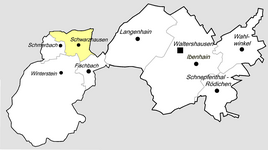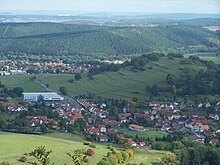Schwarzhausen
|
Schwarzhausen
City of Waltershausen
Coordinates: 50 ° 54 ′ 8 ″ N , 10 ° 28 ′ 13 ″ E
|
|
|---|---|
| Height : | 324 (315-350) m |
| Incorporation : | January 1, 1996 |
| Incorporated into: | Emsetal |
| Postal code : | 99880 |
| Area code : | 036259 |
|
Location of Schwarzhausen in Waltershausen
|
|
|
The outskirts of Schwarzhausen
|
|
Schwarzhausen is a district of Waltershausen in the Gotha district in Thuringia .
geography
Schwarzhausen is located on the northwestern edge of the Thuringian Forest in the valley of the Emse in a valley basin. The surrounding mountains are the Grübelsberg in the southeast (444 m above sea level), the Dachskopf in the east (431 m above sea level), the Deuberg in the north (392 m above sea level) and the Galgenkopf in the southwest (426 m above sea level) ). The from the west lying Schmerbach coming Schmerbach (many maps we find the term "Schmerlingsbach", which goes back to a consideration of Rev. Dr. Berbig, but is fundamentally wrong!) Opens on the border Wartburgkreis in the Emse. The Schmerbach (from smer = greasy, greasy) is the namesake of the neighboring village Schmerbach.
The B 88 from Friedrichroda to Wutha-Farnroda and the L 1027 , which connects the town with Steinbach, run through the town . Also, the place is a county road with Sättelstädt and the same there AS of A 4 connected.
history
Schwarzhausen's origins lie in a Franconian settlement to secure the Franconian Army Road from the 5th century that ran through the town. Schwarzhausen was first mentioned in a document between 780 and 802 as Suarzaloheshusen . The first mentioning document dates from the period 780 to 802, so that the year 787 was a "diced" anniversary year and cannot be scientifically proven. In 1987 the citizens celebrated the 1200th anniversary of the town for a week. The place on the historic Schweinaer Handelsstrasse (the so-called Weinstrasse = wrong translation into High German of "Wäähnstrasse" = dialect for Wagenstrasse) through the Thuringian Forest was partly owned by the Fulda Monastery and, after several changes of ownership in 1458, came to the Property of the Lords of Uetterodt .
In place of the castle built in 1699 there was already a fortified structure. In addition to forestry, agriculture and linen weaving, haulage in particular had great economic importance in the area in earlier times. Weaving and carting experienced a decline at the beginning of the 19th century, after which many residents found their livelihood in hemp processing (syringe hoses, belts). In 1840 a wool combing facility was built in the castle, which offered up to 200 jobs, but was relocated to Ohrdruf in 1868 . Since 1869, after the renovation, the castle was used as a schoolhouse.
Almost every family in the village ran a so-called part-time farming for their own supplies in the past centuries. Very few residents lived directly from their own agriculture, as the soil was mostly barren. After the end of the Second World War, many "resettlers" were accepted into the village. Part of the population also benefited from the land reform carried out in 1945 (lands belonging to the former ducal estate and the lands of the von Wangenheim family). However, it was only the collectivization of agriculture undertaken in the 1960s that brought this branch of industry a fruitful blessing, through the use of suitable machines and the extensive conversion to pasture farming on Schwarzhauser fields. The previously very hard work in meadows and fields had finally come to an end through this excellent and far-sighted transformation. Fortunately, the meadows and fields are still managed by an agricultural cooperative today.
The Schwarzhausen residents also worked in the industrial plants in nearby Ruhla and Seebach , where pipes and clocks were made. A wire weaving mill and a sheet metal factory were established around 1900. During the GDR era there were a large number of companies that also offered jobs to residents from the surrounding communities, such as the so-called "Hosenfabrik" - part of VEB Herrenmoden Erfurt, VEB Metallwaren Schmerbach - Schwarzhausen plant, VEB Schaltbau Ruhla, VEB Thermoplast and others. As a result of the dissolution of the GDR, many jobs were reduced and ultimately all except for the Thermoplast company were liquidated, so that almost all jobs were lost. The industrial park, which was opened in 1993, now offers only a fraction of the jobs that existed in the area before 1990. With the so-called "turning point", tourism with overnight stays in Schwarzhausen also collapsed completely.
In 1996, through the merger with three surrounding communities, Schwarzhausen became part of the unified community of Emsetal . This was dissolved on December 31, 2013 and incorporated into Waltershausen.
Culture and sights
Church of St. Peter and Paul
Presumably from 1039 a chapel should have stood not far from today's church on the site of today's Wintersteiner Straße 2. During this time, apart from the chapel in Langenhain and Sättelstädt, there was only the famous chapel at Glasbach am Rennsteig, which was abandoned in 1521. Between 1450 and 1456, a previous building was built at the current location of the church ( location → ), the tower of which was completed in 1505. After damage in the Thirty Years' War, the tower ball was repaired several times, of which those from 1724 and 1753 are documented. The church had two-story galleries and had a high pitched roof , in the middle of four further turrets (see examples of churches in Mechterstädt ) (→ picture ) and Teutleben (→ picture ). In 1848 it was torn down except for the tower and the building materials were sold. The foundation stone for the new Romanesque building was laid on May 6, 1849. The church was consecrated on July 21, 1850. The old spire was demolished in 1823 due to dilapidation and the tower was designed in its current form in 1840, without the flanking turrets. The church contains a winged altar from the beginning of the 16th century, which comes from the previous church, as well as a relief panel from 1522, which shows the veil of Veronica between the two patron saints Peter and Paul. The baptismal font from 1623, which bears the monogram of Hans Friedrich von Uetterodt , had also been saved from the old church . The Knauf organ was installed in 1858. In the past few years, the church tower has been restored and, with donations from traders, the church tower clock has been overhauled and brought up to the latest technical standards. The curious fact is that the church tower is owned by the community and the nave is owned by the church.
More Attractions
- Half-timbered building Altes Amt
- Economics house on the Deuberg
- Half-timbered building imperial house
- Former old people's home in Wintersteiner Strasse - today "Am Lange Feld"
Culture
Every year, the castle pond festivals of the various associations take place at the romantically situated castle ponds. B. the alphorn meeting .
Personalities
- Paul Baethcke (* 1850 in Reckenthin ; † 1936), was pastor of the village from 1877 to 1890, and from 1892 he devoted himself to the systematic excavation of the ruins of the Cistercian monastery in Georgenthal . The Georgenthal community named a street after him. One of his works is Die Roteln von Admont in Mitteilungen der Vereinigung für Gothaische Geschichte und Altertumsforschung , 1905, Verlag Thienemannsche Hofbuchhandlung, Gotha
- Georg Christoph von Utterodt (~ 1650–1714), landlord in Schwarzhausen
Web links
literature
- Alexander Schreyer, Henri Jäger: 787 - 2012 . Festschrift for the 1225 anniversary of Schwarzhausen. Ed .: Heimatverein Schwarzhausen eV Druckereizentrum Gotha, Schwarzhausen 2012, p. 122 .
- Alexander Schreyer: Chronicle of the place Schwarzhausen (1993-2001)
- Horst H. Müller: “Travel Guide Thuringian Forest and Peripheral Regions” (1977) p. 635 f.
Individual evidence
- ↑ a b A. Schreyer: Chronicle of the place Schwarzhausen . 2001.
- ↑ a b Dagmar Reißig: Comments on Schmerbach's 666th anniversary in 2016
- ↑ a b A. Schreyer and H. Jäger: Festschrift for the 1225 anniversary of Schwarzhausen; Schwarzhausen 2012, p. 4, edition of June 6, 2012, p. 3
- ^ A. Schreyer and H. Jäger: Festschrift for the 1225 anniversary of Schwarzhausen; Schwarzhausen 2012; P. 4
- ↑ Confirmation from the state parliament ( page no longer available , search in web archives ) Info: The link was automatically marked as defective. Please check the link according to the instructions and then remove this notice.
- ↑ a b c d e f g h A. Schreyer: Church history of the place Schwarzhausen , 2001 and 2005
- ↑ Ellrich, Heinke, Hoerenz: Between Hörsel and Wilder Gera , Weimar, 2005, ISBN 3-86160-167-2
- ^ A. Schreyer: Chronicle of the place Schwarzhausen . 2001.



